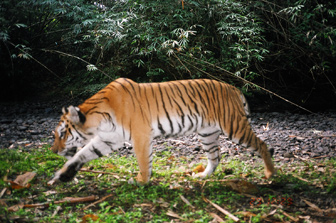5,000 mile-long tiger corridor proposed
mongabay.com
February 13, 2008
|
|
The Wildlife Conservation Society and the Panthera Foundation announced plans to establish a 5,000 mile-long “genetic corridor” from Bhutan to Burma that would span eight countries and allow tiger populations to roam freely across the largest remaining block of tiger habitat. The plan has been endorsed by leading conservationists and the new King of Bhutan, his Majesty Jigme Khesar Namgyel Wangchuck.
Dr. Alan Rabinowitz, director of Science and Exploration Programs at the Wildlife Conservation Society, said the plan offers the best hope for protecting wild tigers.
“While Asia’s economic tigers are on the rise, wild tigers in Asia are in decline,” Rabinowitz said. “Much like the call-out for global agreements on banning tiger parts in trade, a similar cross-border initiative for genetic corridors is key to the survival of the tiger. Tiger range states need to work together, as tigers do not observe political borders nor do they require a visa or passport to travel where habitat and prey remain.”
Rabinowitz said the corridors could include agricultural areas, ranches, and other multi-use landscapes — not just wildlife reserves.
 Photo shows tiger caught in a camera trap in Myanmar’s Hukaung Valley. Credit: Wildlife Conservation Society.
Photo shows tiger caught in a camera trap in Myanmar’s Hukaung Valley. Credit: Wildlife Conservation Society.
“We’re not asking countries to set aside new parks to make this corridor a success,” Rabinowitz said. “This is more about changing regional zoning in tiger range states to allow tigers to move more freely between areas of good habitat.”